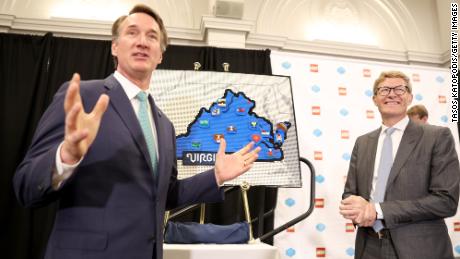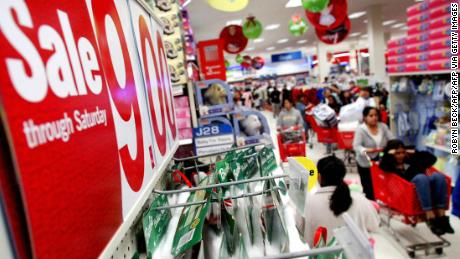New York (CNN)The pandemic sent droves of office employees into yoga pants and t-shirts almost overnight. Now, with more offices reopening and many shifting to a hybrid model, it's looking like a move to more casual wear -- not just for workouts-- may be here to stay.
That's great news for a seemingly unlikely player.
Peloton, whose popular bike and streaming workout classes have surged during the pandemic, said earlier this month that it's launching its own athleisure line, Peloton Apparel. It's the company's first crack at a clothing line developed and designed in-house.
But it could face stiff competition from entrenched players such as Lululemon, Nike and Athleta as well as newcomers like Brooks Brothers, all of whom are fighting for a share of a market estimated by Coresight Research to be roughly $100 billion in the United States.
Jill Foley, Peloton's vice president of apparel, spoke with CNN Business about the company's strategy to win customers.
The following interview has been edited and condensed for clarity, brevity and flow.
CNN BUSINESS: Why are you launching this line now?
JF: It was a reaction to our members asking for it....In the spring of 2015, we started to sell apparel online. As time went on, my model was still to buy [unbranded] clothing and put our logo on it. Then our volume got to such a level that some designers and labels said they wanted make exclusive products for us.
So we started working with brands like Beyond Yoga and Terez. Even Lululemon started selling to us and we could brand it.
But what happened next was that the clothing we were selling frustrated our members because they never knew what a Peloton "small" [size] was because Beyond Yoga's small is different from Terez's small, which is different from Spiritual Gangster's sizing.
We also didn't really have control over quality or design...Finally, in 2018, we realized we just wanted to do this ourselves. We wanted our own production and technical design team to give our members what they wanted... We have this wealth of data from our members over the years -- what works, what doesn't, this waistband is too small, it shows too much when I bend over on the bike. Men saying give us more colors... We've incorporated [this] feedback into our new Peloton apparel.
CNN Business: What lessons have you learned from the pandemic that have helped you with the development of the Peloton Apparel?
JF: What I've learned is that sometimes if you wear a sweatshirt, and it's a nice structured one -- a mock neck, half-zip -- it can feel fancy enough to go to work.
A lot of people will start to bring a casual style to the office, and I want to make sure we are making styles they can do that in. We all got so comfortable working from home. When I go into the office, I'm going to want to wear leggings and a structured sweatshirt. I really do think people will want to stay in this comfortable feeling where they can.
For example, we're going to make nice vests for men that they can throw over a collared shirt. If people go back into the office space, we want them to feel comfortable but look professional and put together.
CNN BUSINESS: The market for athletic and athleisure wear is pretty crowded already. How do you plan to differentiate your line?
JF: My strategy is two-fold. We're focusing on our members. We have six million members. For our members who really enjoy the experience on the bike or the treadmill or the app and want to feel closer to us, the apparel is great for that. They can't buy anything else that says "Peloton" on it.
Also, on a lot of our apparel we put these little love notes on them reminding people why they love their bike, or tread. "Together we go far" is one of our phrases. Others are "Show up," "Make your mark." We're trying to be an extension of their experience on the bike to carry them through their day...On prices, we're working on diversifying the price and democratizing some of the pieces. We try to get tanks as low as $38 to $42. On the high end it's $54.
We're really focused on being inclusive, not only with pricing but with sizing and style.
CNN BUSINESS: Who is the target demographic for Peloton Apparel and where do you see opportunity to expand within that group?
JF: The pandemic did change this a lot. When I started the business, our demographic was men and women equally. Early 30s to early 50s was the demographic.
Now, we see opportunity in younger ages, into the 20s. College-age students are starting to wear Peloton [clothing]. We never used to sell crop tank tops, and now we do.
Also, I used to keep the business focused just on our members. Now we're starting to see people who don't even own a Peloton bike or treadmill buying the apparel...I'm not able to talk too far in the future, but yes, we want to be as inclusive as possible. [Included] in that is maternity and [clothing for] taller people...People want to carry Peloton through their day, from their homes, to coffee, to work, to a night out and even to the beach.
CNN BUSINESS: What is the marketing strategy for Peloton Apparel? How do you plan to create buzz for it?
JF: Our instructors are ambassadors for the brand. They've helped us through the years create the great products, and they wear the brand proudly.
They have also tested the apparel for us. I get feedback weekly from at least one instructor on at least one thing. They're not compensated for wearing it.
They wear it in class. They are permitted to wear other brands, too. A few of them are sponsored by other fitness brands and that's fine. We don't want every instructor to be the same. We want their individual personalities to come out.
We're never going to dictate what they need to wear, but they are asked to wear Peloton on the stream.
CNN BUSINESS: What is the rollout plan for Peloton apparel?
JF: It's online and in stores across North America, UK, Germany and Australia.
We will have our eight seasonal rollouts (two per season) of new products. We'll also do capsules that tie into our brand and our content.
For instance, for Pride Month, we have a lot of Pride fitness content, and we design an outfit with input from our content team and creative teams. We also do that for Black History Month and with music artists.
We did a great Grateful Dead collection where we had classes and my team made apparel for it. Our members could get on the gear and then do the ride wearing it, like a concert-y type feeling.
CNN BUSINESS: What's the plan for how you'll feature Peloton logo on the new clothing? Will it be as big as it appears on the existing clothing?
JF: A lot of our members have asked to make the logo smaller and we are starting to do that. There was a time we did a smaller logo and it didn't sell well. As our member base has gotten so big, and as we are making quality apparel, it's not the logo driving the sale but the quality of the product.
You will start to see very minimal logo on certain styles, specifically on the core styles we are developing.























